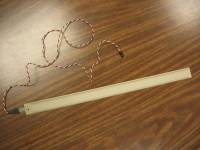This is an old revision of the document!
Table of Contents
Linear Position (Touch)
Summary
Introduction
The linear position touch sensor operates according to a similar set of principles as the force-sensitive resistor. It acts as a variable resistor according to the position at which it is touched. It can therefore be used in a voltage divider configuration in order to be read by a voltage sensing circuit such as an ADC.
Any touch sensor is usually composed of:
- A fully conductive material (copper, etc.)
- An insulated spacing material (plastic or foam)
- An imperfectly conductive material
The partially conductive material presents a resistance to the flow of current. The main principle of the linear position sensor is that the more length of this material that must be traveled by the current, the more opposition there is to the current flow. Therefore, the resistance value of the material may be modified by changing the position at which it makes contact with the fully conductive material.
The resistive material used may be quite different from one touch sensor to the next. Some sensors use conductive ink or special plastics. Cheap, home-made sensors may be constructed using conductive foam or even magnetic tape.
Uses
A characteristic of the touch sensor is that it only maintains its value for as long as it is being activated by an applied pressure. When it is inactive, its resistance value is very high, or infinite. Because of this, the touch position sensor can be used as a kind of valued event trigger. A user might touch it in various places to initiate some process, and at the same instant can provide this process with an initial value depending on the position at which the touch was made.
Most commonly, touch position sensors are interfaced to software routines. In these cases, the software can provide the sensor with this “memory” that it inherently lacks. This can be used in several ways. Firstly, the software can maintain the “last touched” position whenever the sensor is deactivated. By doing this, the touch sensor can be used to create a “virtual” slider. Alternatively or in addition, the software can remember the “first touched” position when the sensor is activated, and interpret all values relative to this. In these cases, the touch sensor can be used to simulate a larger value range than can be used by a traditional slider. It is similar to the act of picking up a mouse and placing it on the other side of the mousepad to reach the far side of the screen. This is typically how the touch pads on many modern laptops work to simulate the feel of moving a mouse. It is also how one usually moves through the playlist on some portable music players that feature touch sensors.
Yet a third alternative is to track only the difference between each successive touch position. By timing these differences, velocity and acceleration can be derived.
In the case of a drawing tablet or laptop touchpad, another use of the linear position touch sensor is exemplified. By placing two square-shaped touch sensors on top of one another, at orthagonal angles, they can be used to determine X and Y positions of a 2-dimensional plane. This has many applications in computer interaction.
Alternatives
This article has discussed linear position sensors implemented as variable resistors. Another method for a similar device is to use capacitive sensing. In fact, this is the method used by Synaptics, which provide touchpads on many laptops and portable media devices. Touch devices utilising capacitive sensing may be visually very similar to resistive touch sensors. Please see Capacitive Sensing for more information.
Devices
| Spectra Symbol ThinPot | |
|---|---|
| Sources | Digikey $11(12.5mm) $65(1000mm) |
| Description | 12.5 to 1000mm long, 10mm wide, 6mm active width. |
| Datasheet | Datasheet for ThinPots |
| Resources | |
| Notes | Searching for Spectra TPS on digikey brings up all ThinPot LPSs. |
| Variants | Spectra Symbol also makes a (wider) SoftPot line and a heat-resistant HotPot line. |
| Infusion Systems SlideLong | |
|---|---|
| Sources | Infusion Systems US$ 68.81 |
| Description | Active area 140mm by 20mm. Resistance range 0 - 3KΩ, or 20KΩ when inactive. |
| Datasheet | |
| Resources | |
| Notes | |
| Variants | SlideLong, with longer active surface. SlideWide, square-shaped active surface. |
| Eowave EOS15 Position (30 cm) | |
|---|---|
| Sources | Eowave 50 Euros |
| Description | Size: 300 mm by 22mm. Weight: 5 g. |
| Datasheet | |
| Resources | |
| Notes | Output TRS jack. |
| Variants | Versions of 10 cm (EOS14, 40 Euros) and 50 cm (EOS16, 60 Euros). |
Media
External links & references
- Nyce, David S., 2003. Linear Position Sensors: Theory and Application. New Jersey: Wiley. ISBN 0471233269
- Synaptics Technologies: Capacitive Position Sensing http://www.synaptics.com/technology/cps.cfm
Home-made devices:


